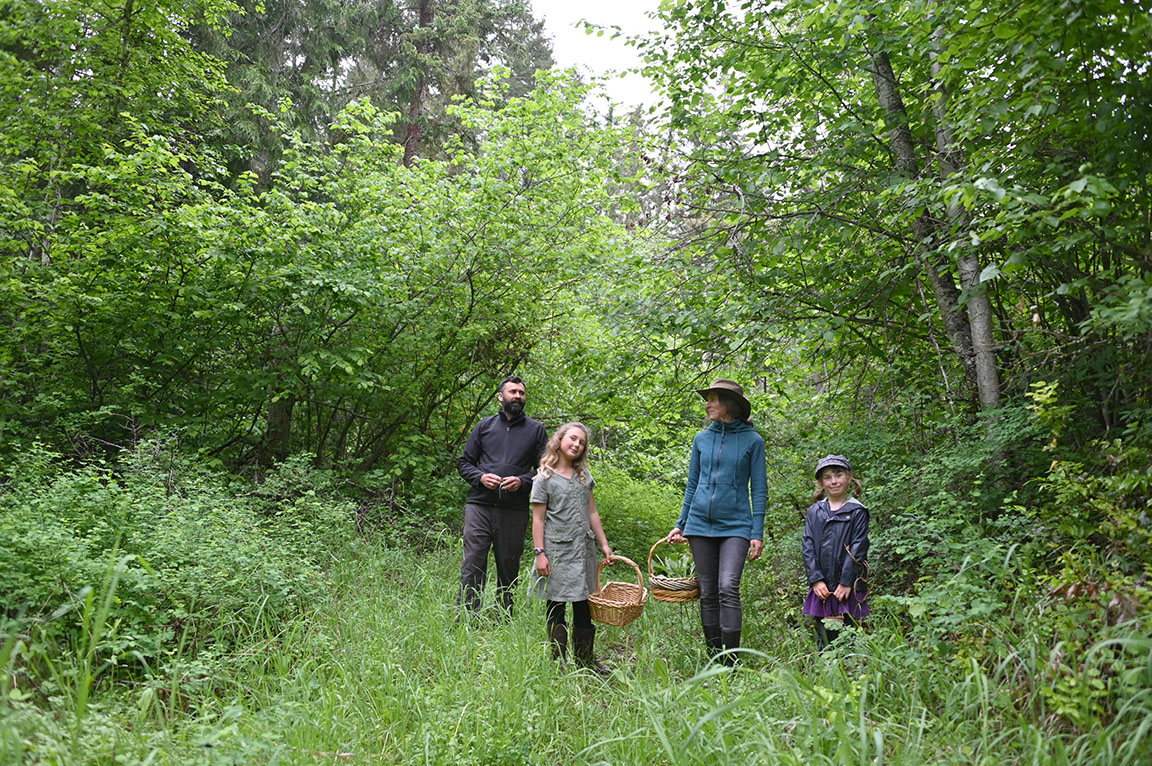Foraging as a Way of Life
When I moved to British Columbia six years ago, it was surprising to see how often chefs included foraged foods on their menus. Golden chanterelles, pine mushrooms, fragrant spruce tips and juicy wild berries added uniquely local flavours to dishes.
The wild-foods spirit soon extended to my pantry, with packages of dehydrated wild morels, seaweed flakes, kelp blades and stinging nettle tea. There’s usually a jar of wild cedar jelly in the fridge.
These are purchased items. I’ve never felt bold enough to stock my kitchen with foods that I had foraged. I worried about the risks. What would happen if I grabbed a basket and headed into the woods for supper? Blame the “poison berry” incident from my childhood, a leftover memory of having my stomach pumped as a preschooler after my mom discovered me nibbling berries from neighbour’s shrub. But meeting author, wildcrafter and forager Mikaela Cannon may help overcome my fears.
Her new book Foraging as a Way of Life: A Year-Round Field Guide to Wild Plants feels as though it’s written for hesitant foragers like me. It’s a year-round field guide for understanding, gathering and using foraged plants and mushrooms.
Cannon, a Swedish-born trained wilderness guide, leads classes on responsible foraging not far from where she lives with her family in the North Okanagan region of British Columbia.
She stresses that she is not a doctor, herbalist or botanist. “If in doubt, leave it out” is her credo. Her knowledge is based on courses she’s taken in herbal medicine, ethnobotany and biology, coupled with a methodical approach to learning about plants by observing them, sometimes for a year or more. As part of her commitment to community building and Truth and Reconciliation, she turns to Indigenous Elders for their plant and nature knowledge.
The book is broken into four seasonal sections. For each month, Cannon focuses on five of her favourite wild plants and mushrooms. Photos and her simple illustrations help with identification. Similar species and lookalikes for each plant or mushroom are listed, along with a red-highlighted box that details health risks and cautions, including which plants can be toxic or cause a rash. Cannon explains the health benefits of each profiled specimen, along with how and when to harvest. Recipes give inspiration for ways to use the plants and mushrooms, from pan-fried dandelion flowers to Ponderosa pine bark crackers.
Foraging as a Way of Life began as a compendium of practical information and family memories for her daughters, 10-year-old Willow and eight-year-old Phoenix. The girls often accompany Cannon on foraging walks around the 90-acre forested farm where the family lives. Cannon and her partner Peter Glimm lease a portion of the land to raise nursery plants, berry bushes and trees to help people start their own food forests.
Born to a Canadian mother and Swedish father, Cannon recalls a childhood where she was always playing outside in the woods, building forts with her friends and randomly picking and tasting plants for their makeshift forest dwelling larder. Many of her favourites from those times are in the book.
Sweden has Allemansrätten legislation, or what we might call “the right to roam.” Canada does not and has restrictions on foraging, including on private and Crown lands and in public parks.
Yet there are places, even in an urban environment, where foragers can pick freely. I meet Cannon on a wet, late-spring day at Spring Ridge Commons, a half-acre public food forest in Victoria’s Fernwood neighbourhood. Cannon takes me along a winding cedar chip path, stopping every few feet to point out something worth tasting.
She’s used to hesitancy from some new foragers when they take one of her classes or workshops.
‘I think that there's a yearning to connect with the land,” she says. “And I see that in a lot of people (who) come out to my classes. They just want to be with a plant. They don’t necessarily want all their meals to come from the forest. But they want to have that connection.”
Cannon does know what it’s like for most of her meals to come from wild sources.
“We did an experiment. I said, ‘Don’t go buying anything in any grocery store. We’re just going to see what we can make.’ So, from April until the end of November, we were able to just eat foraged (food) and stuff we grew,” she says proudly. Protein came from the free-range chickens they raised on the farm.
Cannon continues to live her respect for the land. She preaches harvesting gently and taking small harvests. She even introduces herself to the plants and asks their permission to pluck. She waits until she gets an answer — sometimes she feels a “no” — and if it makes her look silly or appear less than scientific in her approach, she doesn’t mind.
Jumping in to foraging
Feeling relaxed by her kindly approach, I feel ready for a taste of foraging. Cannon points out a disc-shaped, green plant growing close to the ground. “Miner’s lettuce,” she says, popping a leaf in her mouth. I do the same. It’s good. The fresh, juicy leaves had a peppery note that would be perfect in salad.
Could I find it on my own? Cannon explains how to recognize the plant. “It’s got this kind of two leaves that become one leaf and little white flowers in the middle,” she says, holding one so I can see its attributes. The leaves can be larger later in the season, she says. The name came from miners who picked it to get vitamins C and K “and all the other good stuff that they needed while they’re out.”
Next, she points out chickweed (juicy, rich in iron) and filmy wild fennel fronds (great in salads). Stinging nettle is delicious in soup, or dry it for later use in omelettes, she says, picking a leaf and pointing out the stinging hairs on the underside. Cannon taps them on her hands, which she says are often cold. One woman who took her class found relief from arthritis pain in her knee by doing the same.
Cannon says you can pick and eat the raw leaves by folding the undersides inwards and rubbing them to get rid of the stinging hairs. Even her little girls like to do it. I'm skeptical but give it a try. It tastes okay and I know it’s good for me, with iron and vitamins C and A, but I keep fixating on the “stinging” part. Maybe I’m too chicken to forage.
With the approach of autumn, Cannon likes to harvest fibre-rich burdock. Considered a weed in North America, the root is cultivated in Japan, where I had it on pizza, spread across the crust and cooked to blistered softness in a wood oven. It was delicious.
“I really like harvesting the burdock root in the fall,” says Cannon. The tap root is bigger after a season of growth and it’s good in stews. When dried and ground, it can be used as a coffee substitute or flour.
Why not get rid of your invasives by eating them, she jokes. Her partner teases her about how she plants weeds in their planter boxes instead of ornamental flowers. She reminds him that’s what they’re eating for supper.
In the fall, red rosehips are ready to harvest for jams. Yarrow is “an all-round lovely plant,” Cannon says, adding that it’s good for a skin-healing salve or a tea. Its slightly bitter taste made yarrow a favourite beer ingredient among the Vikings.
Cannon says foraging invites people to slow down, be in nature and to be part of the landscape.
“You’re getting inspiration as well as finding food for supper,” she says. “I can’t think of a better way to spend your time. And then you go with your kids and they learn to slow down, too.”
On my way out of the Commons forest, I stop to pick a handful of miner’s lettuce, adding a long frond of wild fennel. Part of that night’s dinner is a salad topped with my foraged bits, some Vancouver Island seaweed and a dash of pride.
How to forage
Cannon says a good way to start learning foraging basics is with a guided walk or workshop. Find foraging groups through social media. Most cities have a naturalist’s club where you can learn about plant identification. Get involved with foraging groups as a volunteer.
If you want to connect with First Nations people about foraging, pay them for sharing their knowledge.
Be mindful and respectful of the plants, people and culture, Cannon says. Certain plants are sacred to certain people. Know that and ask permission. Don’t go in and just take plants. And never clear a patch. Save some for the next person, the next season, the birds and the animals.
Learn more at www.forestfables.ca, Cannon’s website.






